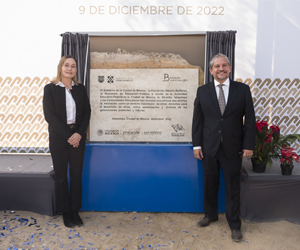ContraRéplica
December 2022
Iztapalapa aims to build state-of-the-art educational model in Santa María Aztahuacán: Clara Brugada

During the Alberto Baillères Foundation’s presentation of the Iztapalapa Educational Habitat project, which will build a school complex in Santa María Aztahuacán, Itzapalapa Mayor Clara Brugada Molina emphasized that the project is an example of the educational model being transformed.
Mayor Brugada stated that this evolution will be reflected in the complex’s three integrated educational levels (pre-primary, primary, and secondary) that will benefit students, five years after its facilities were damaged in the earthquake of 2017.
She celebrated the Alberto Baillères Foundation’s initiative in being an organization that promotes the transformation of educational models and supports school communities; in this case, the community in Iztapalapa and its 3,000 students spread out across the Jardín de Niños Fray Martín de Valencia (Kindergarten), Primaria Herminio Chavarría (Primary School), and Secundaria Luis Pasteur (Secondary School).
“This high-quality initiative is a new way of seeing educational development in schools; schools are students’ second homes and must be the public spaces which are best looked after by governments and supported by society as a whole,” Brugada said.
Addressing the community of Santa María Aztahuacán, the Iztapalapa mayor specified that the area’s public schools and homes have been affected by a fracture system —a geological feature that divides the borough in two. There are more than 2,400 fracture points in Iztapalapa, and schools in the affected zones have been monitored for over 15 years.
In this sense, Brugada also thanked Iztapalapa school principals for participating in integral education models like this one, which has heard their voices in the project’s development through a process of participative community planning.
It is the students who will be most benefited, as they will receive a better-equipped school that will become the city’s best school.
Secretary of Public Education Leticia Ramírez Amaya expressed that it is highly gratifying that the efforts of the private sector, government, and society have come together to build a comprehensive new campus in Iztapalapa that represents the struggle and results of a productive and prosperous society.
Secretary Ramírez celebrated the fact that the Alberto Baillères Foundation is leading these comprehensive models for students that add to new social developments built by Mayor Brugada.
These developments have emphasized that there are opportunities to positively change communities with inclusion and quality for all students and inspire them in their professional development.
Rosa Isela Gluyas, Director of the Alberto Baillères Foundation, noted that in early 2019 the Alberto Baillères Foundation expressed to education authorities its willingness to create an educational habitat in Mexico City to contribute to dignified, inclusive, and equitable education, promoting community development within society in order to elevate Mexico’s greatness through education. To this end, the Foundation assembled a multidisciplinary working team with partnerships and collaboration aimed at achieving this goal.
She stressed that the Alberto Baillères Foundation understands the school space as an educational habitat whose space promotes community participation in order to create integration for education and human development in innovative buildings that present state-of-the-art solutions with a social, individual, and collective conscience for human development as an agent of change and the common good in professional education.
Gluyas highlighted that not only will a large complex for the development of education be created but that it represents the sum of a dynamic system that includes the participation of the school community, all authorities, and society in general so that all involved generate models of transformation from within schools like Jardín de Niños Fray Martín de Valencia (Kindergarten), Primaria General Herminio Chavarría (Primary School), and Secundaria Luis Pasteur (Secondary School) in Iztapalapa, which are education communities and agents of change.
José Eduardo Silva, Alberto Baillères Foundation board member, noted that the community of Santa María Aztahuacán will receive a modern, fully equipped, and well-designed school due this area’s facilities being affected by the earthquakes that damaged its schools. The entire school complex will be open to parents themselves, who will be able to learn different educational disciplines and acquire academic training for their human development.
Also present at the event were Luis Humberto Fernández Fuentes, head of the Mexico City Federal Education Authority (AEFCM); José Eduardo Silva, Alberto Baillères Foundation board member, representing Alejandro Baillères, Foundation President and President of Grupo BAL; José Octavio Figueroa García, Alberto Baillères Foundation board member; Juan Argüello Flores, Director General of Grupo BAL; and Rosa Isela Gluyas, Director of the Alberto Baillères Foundation.
Source ContraRéplica